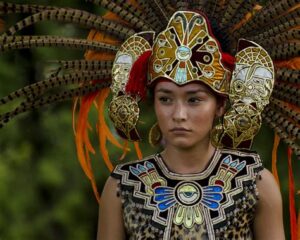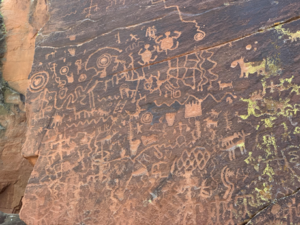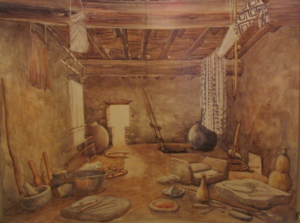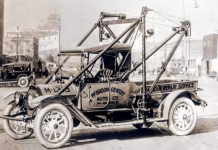We’ll start off by saying that neither part of the name Montezuma Castle is actually correct.
When European-Americans first saw the ruins in the 1860s, by then long-abandoned, they named it for the famous Aztec emperor Montezuma in the mistaken belief that he had been connected to its construction.
 Having no connections to the Aztecs, Montezuma Castle was given that name due to the fact that the public had this image of the Aztecs creating any archaeological site.
Having no connections to the Aztecs, Montezuma Castle was given that name due to the fact that the public had this image of the Aztecs creating any archaeological site.
In fact, the dwelling was abandoned more than 40 years before Montezuma was born, and was not a “castle” in the traditional sense, but instead functioned more like a “high rise apartment complex.”
It was built by the Sinagua, a group of people who lived in the dwellings at Montezuma Castle and Tuzigoot in the Verde Valley, AZ.
Although people were living in the area much earlier, the Sinagua began building permanent living structures – the dwellings you see at the monument – around 1050 AD.
The name “Sinagua” comes from the Spanish “sin agua,” meaning “without water.” Despite the name, the Sinagua actually had plenty of water.
The group was named by Harold S. Colton in 1939, after the San Francisco Peaks, where Colton first identified the culture. (The peaks were called “sierra sin agua” by early Spanish explorers because they lacked rivers and streams.)
 Archeologists divide the Sinagua into two groups: The Northern Sinagua, who lived in the modern-day Flagstaff area, and the Southern Sinagua, who lived in the modern-day Verde Valley. They share much in common, but there are a few cultural differences.
Archeologists divide the Sinagua into two groups: The Northern Sinagua, who lived in the modern-day Flagstaff area, and the Southern Sinagua, who lived in the modern-day Verde Valley. They share much in common, but there are a few cultural differences.
Montezuma Castle and Tuzigoot National Monument protect Southern Sinagua dwellings. You can find Northern Sinagua dwellings at Wupatki and Walnut Canyon.
The Sinagua were living in the Verde Valley as early as 650 AD, or maybe even earlier. The earliest houses they built were called pithouses, made by digging partially into the ground, inserting log posts, and covering the structure with plant material. The remains of one pithouse can be seen at Montezuma Well.
Beginning around 1050 AD, the Sinagua began building pueblos and cliff dwellings. They built homes in naturally occurring caves in the cliffs using local materials like wood, stone, and mud mortar.
Cliff dwellings often had multiple levels, and were accessed using wooden ladders.
There are many possible reasons the Sinagua chose to build their homes in the cliffs. At Montezuma Castle, the cliff faces south, so the dwellings are warm in the winter and cool in the summer. The high location also protected them from damage caused by the annual flooding of Beaver Creek. The dwellings may also have been built high up for protection or to help the Sinagua view approaching travelers.
 Despite being called a castle, the dwelling at Montezuma Castle is actually a collection of 20 rooms originally belonging to multiple families, similar to a modern-day apartment building. Other apartment-style buildings called pueblos, like those found at Montezuma Well and Tuzigoot also had multiple rooms and were built with local materials. But unlike Montezuma Castle, these pueblos are free-standing and have large common areas for gatherings. The Sinagua lived in pueblos and cliff dwellings until around 1400 AD.
Despite being called a castle, the dwelling at Montezuma Castle is actually a collection of 20 rooms originally belonging to multiple families, similar to a modern-day apartment building. Other apartment-style buildings called pueblos, like those found at Montezuma Well and Tuzigoot also had multiple rooms and were built with local materials. But unlike Montezuma Castle, these pueblos are free-standing and have large common areas for gatherings. The Sinagua lived in pueblos and cliff dwellings until around 1400 AD.
The Sinagua did not disappear, but rather migrated away over time. Montezuma Castle was abandoned around 1400 AD, as were the dwellings at Montezuma Well. Although we do not know the exact reason, possible explanations include environmental change, overpopulation, social conflict, or religious reasons. Unfortunately the Sinagua had no written language, leaving us to piece together why they left.
Although the Sinagua left about 600 years ago, the Verde Valley has been continually occupied by other groups of people. Some Hopi clans believe that the Sinagua were their ancestors. Some Yavapai-Apache say that not all Sinagua left, but instead integrated with the Yavapai and Apache. Today, the monument is affiliated with many tribes, including the Four Southern Tribes of Arizona, Yavapai, Apache, Hopi, and Zuni.
You can learn more about the Montezuma Castle and it’s people by visiting: https://www.history.com/topics/landmarks/montezuma-castle






